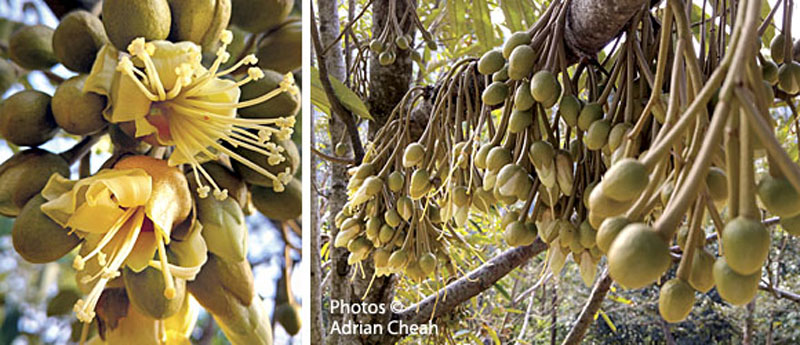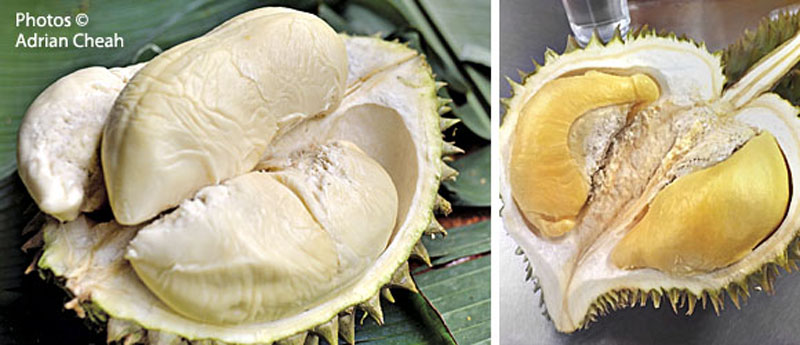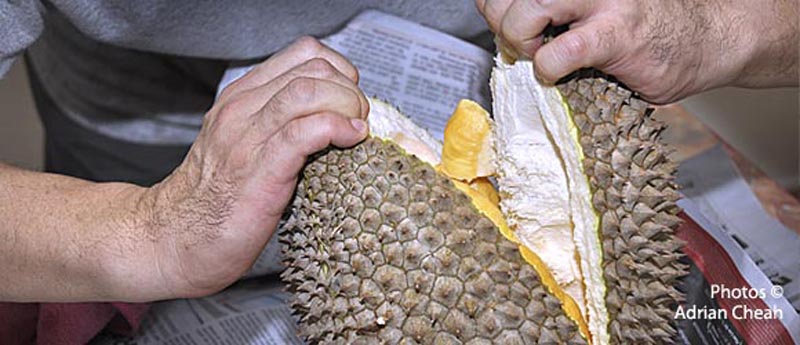Durian, the sensational "King of the Fruits"

“You should wash your hands using water poured over the inside chambers of a hollowed durian skin. It will remove the strong odour from your fingers", urged Mr Teh, my neighbour who accompanied me on a durian feast at one of the many durian orchards in Balik Pulau. That morning, we had a satisfying breakfast like no other, amidst the natural surroundings of the orchard, shaded by towering durian trees.

Mr Nah Gin Guan, the son of the durian orchard's tenant, was skilful in opening the durians. With a sharp cleaver, he pried open each fruit at the tail end where the indicative slicing lines met.
Having said that, I have come across fruits where the inner skin merged and would not give way to the thrust of the knife, sometimes resulting in a tussle that drew blood.
Come durian season, for as far as I can remember, my late father deployed a wooden stump approximately eight inches long with a slightly tapered end to do the same job. On the other hand, I would now prefer the much safer and easier method – to seek the assistance of the durian seller to open part of the fruit for me. This way, I would be certain of the quality I am paying for.

The durian tree (Bombaceae, Durio zibethius L.Murr) is native to moist equatorial forests in Southeast Asia. It can reach up to a 100 feet tall, producing heavy, thick-skinned, brownish-green, soccer-ball sized fruits covered with sharp thorns.
The word “durian” comes from “duri” which is Bahasa Malaysia for thorn. Therefore the durian, by name, is a thorny fruit. Each individual fruit is divided into five compartments containing seeds, each covered by a sac of thick, creamy pulp with an aroma that is "legendary".
A popular belief is that the older the tree, the better the fruit. Older durian trees bear fruits that have buttery-smooth, thick and creamy flesh, often with a stronger "fragrance" and flavour.

Usually, trees grown from seeds will start bearing fruit after about five to six years. Sometimes, four to five-year old trees can start to flower as well. A mature durian tree will often produce flowers after a hot and dry spell of about three to four weeks. One month later, the flowers will be in full bloom. Three months after that, durian fruits will start to ripen and drop.
The “champion” durians which we savoured that morning were from trees that were more than 40 years of age, amounting to about 65 percent of the trees at the orchard. According to Mr Nah, the initial yield may be between 10 to 40 fruits for the first few years of flowering to about 100 fruits from the sixth year onwards. Yields of up to 200 fruits are common after the tenth year of fruiting. During each durian season, Mr Nah's 30-acre orchard (which combines two farms) can harvest approximately 15,000 fruits.

The durian season bears one crop a year; however in some instances trees may flower twice a year if influenced by the right conditions. Normally, durians are allowed to drop when they ripen. However, it is a common practice in Thailand to harvest most fruits. By harvesting, the shelf life would be extended from nine to 11 days, compared to one or two days when allowed to drop from the tree.

Good durians are like priced wines or gourmet cheeses. They are a food for connoisseurs. For genuine durian lovers, differentiating taste in accordance to variety seems like true science.
To judge the quality of a durian, there are three important criteria to consider. First is the appearance of the flesh. The colour must be even, ranging from off-white to bright egg yellow, to strong yellowish orange. Second is its aroma. The fruit must have a strong intense bouquet, locally known as "hong". "Hong" marks the satisfactory oomph, the extra kick of the fruit in all aspects as well. I cannot find an English word that best describes "hong". Thirdly, the texture and taste should be creamy and wet or creamy and dry, sweet or bitter sweet, some even with an alcoholic punch. The smooth pulp should fully cover the entire seed.


Different people crave different varieties. The sweeter durians are yellowish and creamy in texture. These include high-sounding names like Hor Loh, Lipan, Green Skin, D2, D15, D95 and Kun Poh. The optional bitter-sweet variety is usually pale in colour, reminding me of a blue-and-black pinch wound that is easing off. According to Mr Nah, the orange-coloured variety (e.g., Ang Heh literally means red prawn in Hokkien) is usually not as sweet as the yellowish type. His orchard had as many as 20 varieties of "branded" durians and more that 50 other types waiting to be given names.
In the days of olde, there was only one species of fruit, the old tree/kampung variety. Now there is a bit of hair splitting (more of a selling gambit!) as the kampung/old tree variety would often be tagged with a few fancier labels to justify a higher price.

That morning, the durian buffet included some of the above varieties. My preferences were the yellowish fruits called D604 and D14. They had thick flesh with rich, sweet butter-like flavours. Enjoying the durians at the orchard from freshly harvested fruits indeed guarantee their quality. It was a chance to get one’s fill of the very best.
The selected fruits that morning were of average sizes. They were not as humongous as the Thai variety. The Thai durians are packed with bulging pulp that is less creamy and rather bland in taste. Here, more flesh definitely does not assure better quality.
I always remember that after a hefty durian feast, my mother would recommend that my brothers, sisters and I fill empty durian shells with water and add a pinch of salt before drinking it. The shell supposedly contains properties that would help cool the body.
We were also cautioned not to consume alcohol along with durians, before and even after eating the durians. This is because one might experience discomfort otherwise. Of course, my mother said in a-matter-of-fact tone that we would die if we did not heed her warning. She would further elaborate, citing gruesome examples of dead uncles.
Famed Victorian naturalist and evolutionary theorist Alfred Russle Wallace wrote, "To eat durian is a new sensation worth a voyage to the East to experience". He spent eight years (1854 to 1862) exploring the Malay Archipelago including Malaya, Singapore, the islands of Indonesia (then known as the Dutch East Indies) and New Guinea. He must have discovered that beyond the pungent aroma of the fruit lay something truly divine within.

We walked away from the durian buffet with wide smiles on our faces, feeling extremely satisfied and being able to share Wallace’s experience. We each paid Mr Nah RM15 and vowed to return the following week to relish the sensation again before this durian season drew to an end.
If you have not sampled durians before, I highly encourage you to do so. You will either love it or hate it and there are no two ways about it. Whatever the consensus is, one must admit there is nothing quite like the durian, the "King of Fruits".
................................................................................
The above story was written a long time back, almost 20 years ago.
In September 2017, a good friend from Canada and I decided to enjoy a durian treat although we were aware that prices would be steep. How steep, you might ask? Well, we had a D24 and an Ang Heh for RM 110 each bringing the total to RM 220 for just two medium-sized fruits. Although ridiculously expensive, we indulged our cravings.
"What has happened to the prices of Penang durians through the years?"
Is it because of the poor harvests? Is it because more Penang durians are now being exported to China? Is it because of smart branding exercises? Or could it be that tourists in Penang are willing to fork out more to get their hands on the King of Fruits?
All I can say is that the durian buffet I enjoyed for only RM 15 is from a distant past. Those were the good olde days.
................................................................................
Photographed and written by Adrian Cheah
© All rights reserved
Updated: 31 March 2022